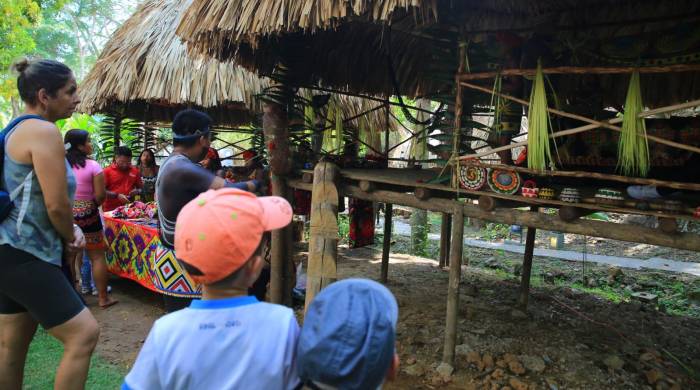Saturday was nice, if missed be sure to attend next year.
- By : James Bryson
- Category : Local Culture

This Saturday, April 20, the Mi Pueblito Interiorano Complex, Las Aldeas Indígenas and Mi Pueblito Afroantillano once again shines in all its splendor with activities alluding to the national identity, from 10 am to 11 pm
Inaugurated in June 1993, the Mis Pueblitos Municipal Tourist Center was erected on the slopes of Cerro Ancón with the purpose of serving as a cultural showcase of Panamanian identity.
To rescue the emblematic complex that has already turned 30 years old as a source of vernacular appreciation, the Mayor’s Office of Panama promoted the recovery of Mi Pueblito Interiorano and the reconstruction of Las Aldeas Indígenas.
My Little Interior Town
Established by Municipal Agreement 107 of July 25, 2000, Mi Pueblito Interiorano was reaffirmed as part of a site representative of the architecture of the interior provinces.
Its renovation included its precious structures: the plaza with a fountain, the parish, its chapel and priestly house with three rooms, telegraphy, the ‘Petita Escobar’ dance school and the ‘Dora Pérez de Zárate’ Pollera Museum.
A mud board made up of a dozen farmers from the interior of the country and visitors put ‘feet to work’ to begin the ‘caging’ work on November 19, 2023.
This is how the particular renovation of wooden, quincha, adobe structures and the placement of the original tiles brought from Azuero took shape.
The Indigenous Villages From its foundations, My Pueblitos Indigenous Villages were re-erected, highlighting the ancestry that replicates the characteristic tambos and huts of the Gnäbe-Buglé, Guna, Emberá-Wounaan, Bri Bri and Naso regions.
At the end of 2018 the original structures were absorbed by nature and weather conditions, and were closed for safety reasons.
On June 22, 2022, reusing the characteristic geography of the slopes of the hill, work began with lightweight materials, typical of the humid jungle, complemented by the development of green areas.
Guágara palm and cane brava, without walls characterized the buildings of the Guna Village, penca roofs, as well as raised ridges on loquat forks, moorings of real rattan and cured wood, gave way to the replicas of more regional homes.
The Guna Village was made up of the Chicha House, the Congress House, the Fonda House, the Kitchen House, the central plaza, the pier and coast, waterfall and paths.
The Gnäbe-Buglé ranches and four Emberá-Wounnán homes join the regional simulation, plus the administrative office, with lighting, amphitheater and rest areas.
The investment of B/.2,086,501 of the decentralization budget and due maintenance ensures its preservation for the next 30 years.
Mi Pueblito AfroantillanoRemodeled in 2018, Mi Pueblito Afroantillano has received intensive maintenance and periodic revitalization of its main buildings: the Müller House, Anglican Church and the Bocatoreño restaurant.
In addition, the conditioning of the House of the lodge, the Afro-Antillean Museum, the House of Crafts, the Guachapali House, the gazebo, the central plaza and the pond that simulates the Caribbean Sea with its panoramic viewpoint.
It has been important to respect the original design, the bright colors that identified its residences and the cobblestones of the central square that now have street furniture.
Mis Pueblitos shines againThe Mis Pueblitos Complex is visited by about 50 thousand national and foreign tourists who come annually to enjoy the environments and the multiple activities.
To enter these facilities, nationals and residents pay $1, foreign visitors pay $3, and children under 5 years of age and retirees enter free of charge.
Mis Pueblitos now has an improved parking space, fire safety system, drinking water supply system, sewage system, gas system for the restaurant and new rest areas.



No Comments